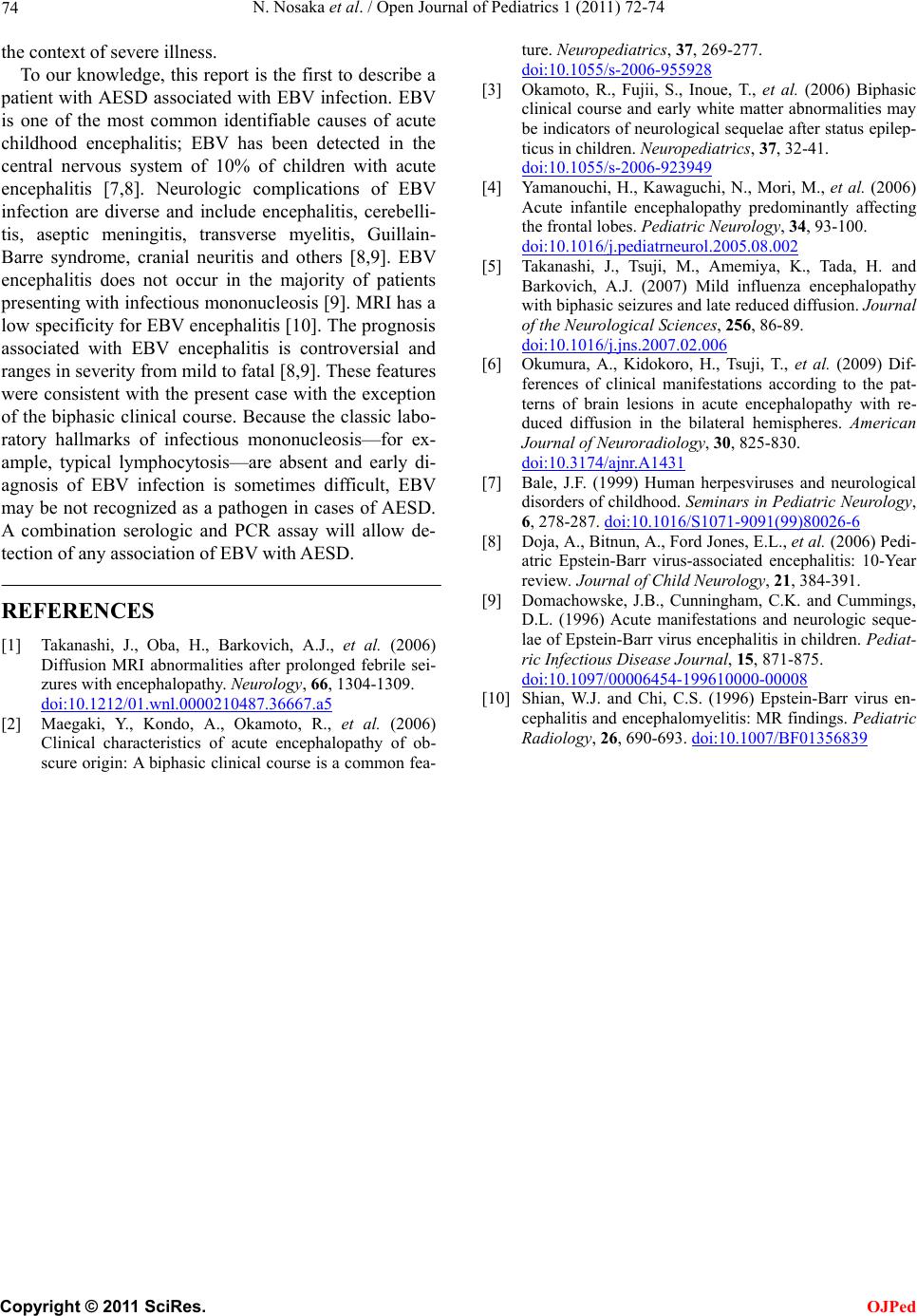
N. Nosaka et al. / Open Journal of Pediatrics 1 (2011) 72-74
Copyright © 2011 SciRes. OJPed
74
the context of severe illness.
To our knowledge, this report is the first to describe a
patient with AESD associated with EBV infection. EBV
is one of the most common identifiable causes of acute
childhood encephalitis; EBV has been detected in the
central nervous system of 10% of children with acute
encephalitis [7,8]. Neurologic complications of EBV
infection are diverse and include encephalitis, cerebelli-
tis, aseptic meningitis, transverse myelitis, Guillain-
Barre syndrome, cranial neuritis and others [8,9]. EBV
encephalitis does not occur in the majority of patients
presenting with infectious mononucleosis [9]. MRI has a
low specificity for EBV encephalitis [10]. The prognosis
associated with EBV encephalitis is controversial and
ranges in severity from mild to fatal [8,9]. These features
were consistent with the present case with the exception
of the biphasic clinical course. Because the classic labo-
ratory hallmarks of infectious mononucleosis—for ex-
ample, typical lymphocytosis—are absent and early di-
agnosis of EBV infection is sometimes difficult, EBV
may be not recognized as a pathogen in cases of AESD.
A combination serologic and PCR assay will allow de-
tection of any association of EBV with AESD.
REFERENCES
[1] Takanashi, J., Oba, H., Barkovich, A.J., et al. (2006)
Diffusion MRI abnormalities after prolonged febrile sei-
zures with encephalopathy. Neurology, 66, 1304-1309.
doi:10.1212/01.wnl.0000210487.36667.a5
[2] Maegaki, Y., Kondo, A., Okamoto, R., et al. (2006)
Clinical characteristics of acute encephalopathy of ob-
scure origin: A biphasic clinical course is a common fea-
ture. Neuropediatrics, 37, 269-277.
doi:10.1055/s-2006-955928
[3] Okamoto, R., Fujii, S., Inoue, T., et al. (2006) Biphasic
clinical course and early white matter abnormalities may
be indicators of neurological sequelae after status epilep-
ticus in children. Neuropediatrics, 37, 32-41.
doi:10.1055/s-2006-923949
[4] Yamanouchi, H., Kawaguchi, N., Mori, M., et al. (2006)
Acute infantile encephalopathy predominantly affecting
the frontal lobes. Pediatric Neurology, 34, 93-100.
doi:10.1016/j.pediatrneurol.2005.08.002
[5] Takanashi, J., Tsuji, M., Amemiya, K., Tada, H. and
Barkovich, A.J. (2007) Mild influenza encephalopathy
with biphasic seizures and late reduced diffusion. Journal
of the Neurological Sciences, 256, 86-89.
doi:10.1016/j.jns.2007.02.006
[6] Okumura, A., Kidokoro, H., Tsuji, T., et al. (2009) Dif-
ferences of clinical manifestations according to the pat-
terns of brain lesions in acute encephalopathy with re-
duced diffusion in the bilateral hemispheres. American
Journal of Neuroradiology, 30, 825-830.
doi:10.3174/ajnr.A1431
[7] Bale, J.F. (1999) Human herpesviruses and neurological
disorders of childhood. Seminars in Pediatric Neurology,
6, 278-287. doi:10.1016/S1071-9091(99)80026-6
[8] Doja, A., Bitnun, A., Ford Jones, E.L., et al. (2006) Pedi-
atric Epstein-Barr virus-associated encephalitis: 10-Year
review. Journal of Child Neurology, 21, 384-391.
[9] Domachowske, J.B., Cunningham, C.K. and Cummings,
D.L. (1996) Acute manifestations and neurologic seque-
lae of Epstein-Barr virus encephalitis in children. Pediat-
ric Infectious Disease Journal, 15, 871-875.
doi:10.1097/00006454-199610000-00008
[10] Shian, W.J. and Chi, C.S. (1996) Epstein-Barr virus en-
cephalitis and encephalomyelitis: MR findings. Pediatric
Radiology, 26, 690-693. doi:10.1007/BF01356839